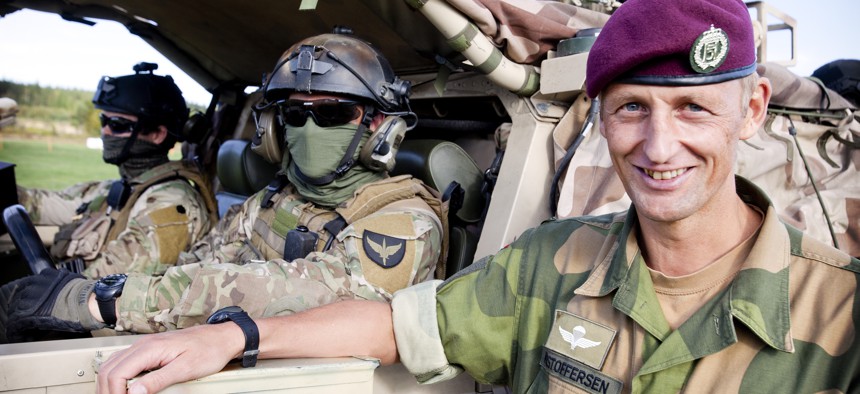
Major-General Eirik Kristoffersen of the Norwegian Army Norwegian Armed Forces
There Are More and More Threats that Militaries Can't Stop. People's Forces Can Help
Populations are not fragile flowers – far from it. Treating them as a national-security resource can boost a society's resiliency, and even its deterrence.
Major-General Eirik Kristoffersen of the Norwegian Army is the quintessential soldier, a special forces officer who has done several tours in Afghanistan and commanded Norway’s Special Forces Command. So his newest appointment — as commander of Norway’s home guard, the Heimevernet — shows how homeland defense is a rising concern for national security leaders. And Norwegian-style People Power is the answer.
“All Heimevernet’s 40,000 members have completed military training, but they’re civilians,” Kristoffersen said in an interview. “Ordinarily, they do things like search-and-rescue and clean up after natural disasters, but they can also be used as a local response force in case of an attack. Because more than 90 percent are assigned to their home areas, they also notice subtle changes that most people wouldn’t see, and report it to the police.”
Western armed forces haven’t had to focus on homeland defense since the end of the Cold War. Instead, troops have been dispatched to Iraq, Afghanistan, and elsewhere. Just last November, NATO announced it would boost its presence in Afghanistan by 3,000 soldiers.
But the threats to Western homelands are increasing. Russia and China have developed precision missiles that can strike accurately over several hundred kilometers. Governments and freelance operators are working on ways to hack critical national infrastructure. The Lloyd’s insurance firm estimates that a successful disruption of the power grid in the northeastern United States would leave 93 million people without power — and could disrupt water supplies, throw transportation into chaos, undermine trade, and even kill. Earlier this year, UK Defense Secretary Gavin Williamson warned that attacks on critical infrastructure could cause “thousands of thousands of deaths.”
Even poison is emerging as a national security threat. In Salisbury, the UK government informed several hundred residents that they may have been exposed to the toxic that killed Russian double agent Sergei Skripal. Shopkeepers are suffering as fearful residents stay home. A professor who has advised the Russian government on public health told me that Russia could even weaponize its sky-high multidrug-resistant tuberculosis rates among prisoners; regional studies show that between 12 and 71.2 percent of prisoners suffer from the disease. “Putin would just need to send a planeload of prisoners to a Western capital,” the professor told me. As the 2018 U.S. National Defense Strategy points out, in italics, the homeland is no longer a sanctuary.
But how is a country to deter attacks committed not by invading forces but by elusive perpetrators operating by completely different means? The painful answer: it’s impossible. Western armed forces can modernize and improve readiness to keep pace with Russia and China’s militaries – but they can’t completely protect their population from every conceivable danger. Even by vastly increasing defense spending, the U.S. and its European allies would not be able to permanently guard all critical infrastructure, let alone pubs and pizzerias – and sentries would at any rate not be able to prevent cyber-attacks or poisonings. What’s more, many citizens would feel uneasy at such a pervasive military presence.
Besides, armed forces struggle mightily to even recruit enough troops to deter conventional attacks. “I would argue that the next existential threat we have…is the inability to man our military,” Maj. Gen. Malcolm Frost, the commander of the US Army’s Initial Training Command, recently noted. The British armed forces need to recruit 10,000 new soldiers each year but only manage 7,000. And in Sweden, the military’s recruitment problems have forced the government to reintroduce the selective draft.
That brings us to the population. In a national security emergency, Major-General Kristoffersen’s Heimevernet members would evacuate residents, distribute food, and guard sensitive sites. The Heimevernet is cost-effective, too, with members compensated only for missed days of work. “It’s a force that can react to unpredictable developments,” Kristoffersen said. Indeed, when called up for unannounced exercises the majority of Heimevernet members report for duty within several hours.
Better yet, the entire population can be involved in national resilience: call it People Power. Sweden is preparing a brochure ("If the War Comes") to be sent to all households, and the country’s National Defense University recently inaugurated a center for total defense and societal resilience. In Denmark, the government conducts regular crisis-management exercises with businesses and civil organizations. A hybrid attack on Norway – or Denmark and Sweden, which also have Heimevernet-style Home Guards — would not cause catastrophic damage of the kind that Lloyd’s predicts in the United States.
Imagine what other countries could achieve with Scandinavian-style People Power. And there’s potential for even better resilience. “It would be incredibly positive for society if young people, say up to 25 years old, completed some form of total defense training in their home communities,” suggested Commodore Ewa Skoog Haslum of the Swedish Navy, the Swedish National Defense University’s deputy vice-chancellor. “It could last for a couple of months and include things like individual crisis preparation, basic medical training, survival skills, and disinformation detection.”
No country can prevent every attack, but the population itself can soften its blow – and that in itself is a deterrent. Because Mother Nature, too, poses an increasingly worrisome threat to our societies, countries must at any rate prepare for emergencies. Ordinary citizens and policy-makers alike have become used to the armed forces alone being responsible for national security. But populations are not a fragile flower – far from it. Let’s treat them as a resource.
NEXT STORY: Telling the Truth About CIA Torture




